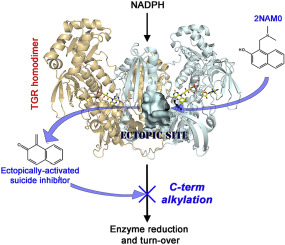当前位置:
X-MOL 学术
›
Free Radical Bio. Med.
›
论文详情
Our official English website, www.x-mol.net, welcomes your
feedback! (Note: you will need to create a separate account there.)
Ectopic suicide inhibition of thioredoxin glutathione reductase.
Free Radical Biology and Medicine ( IF 7.1 ) Pub Date : 2019-12-20 , DOI: 10.1016/j.freeradbiomed.2019.12.019 Ilaria Silvestri 1 , Haining Lyu 2 , Francesca Fata 1 , Paul R Banta 2 , Benedetta Mattei 1 , Rodolfo Ippoliti 1 , Andrea Bellelli 3 , Giuseppina Pitari 1 , Matteo Ardini 1 , Valentina Petukhova 4 , Gregory R J Thatcher 4 , Pavel A Petukhov 4 , David L Williams 2 , Francesco Angelucci 1
Free Radical Biology and Medicine ( IF 7.1 ) Pub Date : 2019-12-20 , DOI: 10.1016/j.freeradbiomed.2019.12.019 Ilaria Silvestri 1 , Haining Lyu 2 , Francesca Fata 1 , Paul R Banta 2 , Benedetta Mattei 1 , Rodolfo Ippoliti 1 , Andrea Bellelli 3 , Giuseppina Pitari 1 , Matteo Ardini 1 , Valentina Petukhova 4 , Gregory R J Thatcher 4 , Pavel A Petukhov 4 , David L Williams 2 , Francesco Angelucci 1
Affiliation

|
Selective suicide inhibitors represent a seductively attractive approach for inactivation of therapeutically relevant enzymes since they are generally devoid of off-target toxicity in vivo. While most suicide inhibitors are converted to reactive species at enzyme active sites, theoretically bioactivation can also occur in ectopic (secondary) sites that have no known function. Here, we report an example of such an "ectopic suicide inhibition", an unprecedented bioactivation mechanism of a suicide inhibitor carried out by a non-catalytic site of thioredoxin glutathione reductase (TGR). TGR is a promising drug target to treat schistosomiasis, a devastating human parasitic disease. Utilizing hits selected from a high throughput screening campaign, time-resolved X-ray crystallography, molecular dynamics, mass spectrometry, molecular modeling, protein mutagenesis and functional studies, we find that 2-naphtholmethylamino derivatives bound to this novel ectopic site of Schistosoma mansoni (Sm)TGR are transformed to covalent modifiers and react with its mobile selenocysteine-containing C-terminal arm. In particular, one 2-naphtholmethylamino compound is able to specifically induce the pro-oxidant activity in the inhibited enzyme. Since some 2-naphtholmethylamino analogues show worm killing activity and the ectopic site is not conserved in human orthologues, a general approach to development of novel and selective anti-parasitic therapeutics against schistosoma is proposed.
中文翻译:

异位自杀抑制硫氧还蛋白谷胱甘肽还原酶。
选择性自杀抑制剂代表了一种使治疗相关酶失活的诱人方法,因为它们通常在体内没有脱靶毒性。尽管大多数自杀抑制剂在酶活性位点转化为反应性物种,但从理论上讲,生物激活也可以在功能未知的异位(次级)位点发生。在这里,我们报告这种“异位自杀抑制”的例子,这是一种由硫氧还蛋白谷胱甘肽还原酶(TGR)的非催化位点实现的自杀抑制剂前所未有的生物激活机制。TGR是治疗血吸虫病(一种毁灭性的人类寄生虫病)的有希望的药物靶标。利用从高通量筛选活动,时间分辨X射线晶体学,分子动力学,质谱,分子建模,蛋白质诱变和功能研究,我们发现绑定到曼氏血吸虫(Sm)TGR的这个新型异位位点的2-萘酚甲基氨基衍生物被转化为共价修饰剂并与其可移动的含硒代半胱氨酸的C末端臂反应。特别地,一种2-萘酚甲基氨基化合物能够在被抑制的酶中特异性地诱导前氧化活性。由于某些2-萘酚甲基氨基类似物显示出蠕虫杀伤活性,而异位点在人类直系同源物中不保守,因此提出了开发针对血吸虫病的新型选择性选择性抗寄生虫疗法的一般方法。我们发现绑定到曼氏血吸虫(Sm)TGR的这个新的异位部位的2-萘酚甲基氨基衍生物被转化为共价修饰剂,并与其可移动的含硒代半胱氨酸的C末端臂反应。特别地,一种2-萘酚甲基氨基化合物能够在被抑制的酶中特异性地诱导前氧化活性。由于某些2-萘酚甲基氨基类似物显示出蠕虫杀伤活性,而异位点在人类直系同源物中不保守,因此提出了开发针对血吸虫病的新型选择性选择性抗寄生虫疗法的一般方法。我们发现绑定到曼氏血吸虫(Sm)TGR的这个新的异位部位的2-萘酚甲基氨基衍生物被转化为共价修饰剂,并与其可移动的含硒代半胱氨酸的C末端臂反应。特别地,一种2-萘酚甲基氨基化合物能够在被抑制的酶中特异性地诱导前氧化活性。由于某些2-萘酚甲基氨基类似物显示出蠕虫杀伤活性,而异位点在人类直系同源物中不保守,因此提出了开发针对血吸虫病的新型选择性选择性抗寄生虫疗法的一般方法。
更新日期:2019-12-20
中文翻译:

异位自杀抑制硫氧还蛋白谷胱甘肽还原酶。
选择性自杀抑制剂代表了一种使治疗相关酶失活的诱人方法,因为它们通常在体内没有脱靶毒性。尽管大多数自杀抑制剂在酶活性位点转化为反应性物种,但从理论上讲,生物激活也可以在功能未知的异位(次级)位点发生。在这里,我们报告这种“异位自杀抑制”的例子,这是一种由硫氧还蛋白谷胱甘肽还原酶(TGR)的非催化位点实现的自杀抑制剂前所未有的生物激活机制。TGR是治疗血吸虫病(一种毁灭性的人类寄生虫病)的有希望的药物靶标。利用从高通量筛选活动,时间分辨X射线晶体学,分子动力学,质谱,分子建模,蛋白质诱变和功能研究,我们发现绑定到曼氏血吸虫(Sm)TGR的这个新型异位位点的2-萘酚甲基氨基衍生物被转化为共价修饰剂并与其可移动的含硒代半胱氨酸的C末端臂反应。特别地,一种2-萘酚甲基氨基化合物能够在被抑制的酶中特异性地诱导前氧化活性。由于某些2-萘酚甲基氨基类似物显示出蠕虫杀伤活性,而异位点在人类直系同源物中不保守,因此提出了开发针对血吸虫病的新型选择性选择性抗寄生虫疗法的一般方法。我们发现绑定到曼氏血吸虫(Sm)TGR的这个新的异位部位的2-萘酚甲基氨基衍生物被转化为共价修饰剂,并与其可移动的含硒代半胱氨酸的C末端臂反应。特别地,一种2-萘酚甲基氨基化合物能够在被抑制的酶中特异性地诱导前氧化活性。由于某些2-萘酚甲基氨基类似物显示出蠕虫杀伤活性,而异位点在人类直系同源物中不保守,因此提出了开发针对血吸虫病的新型选择性选择性抗寄生虫疗法的一般方法。我们发现绑定到曼氏血吸虫(Sm)TGR的这个新的异位部位的2-萘酚甲基氨基衍生物被转化为共价修饰剂,并与其可移动的含硒代半胱氨酸的C末端臂反应。特别地,一种2-萘酚甲基氨基化合物能够在被抑制的酶中特异性地诱导前氧化活性。由于某些2-萘酚甲基氨基类似物显示出蠕虫杀伤活性,而异位点在人类直系同源物中不保守,因此提出了开发针对血吸虫病的新型选择性选择性抗寄生虫疗法的一般方法。











































 京公网安备 11010802027423号
京公网安备 11010802027423号